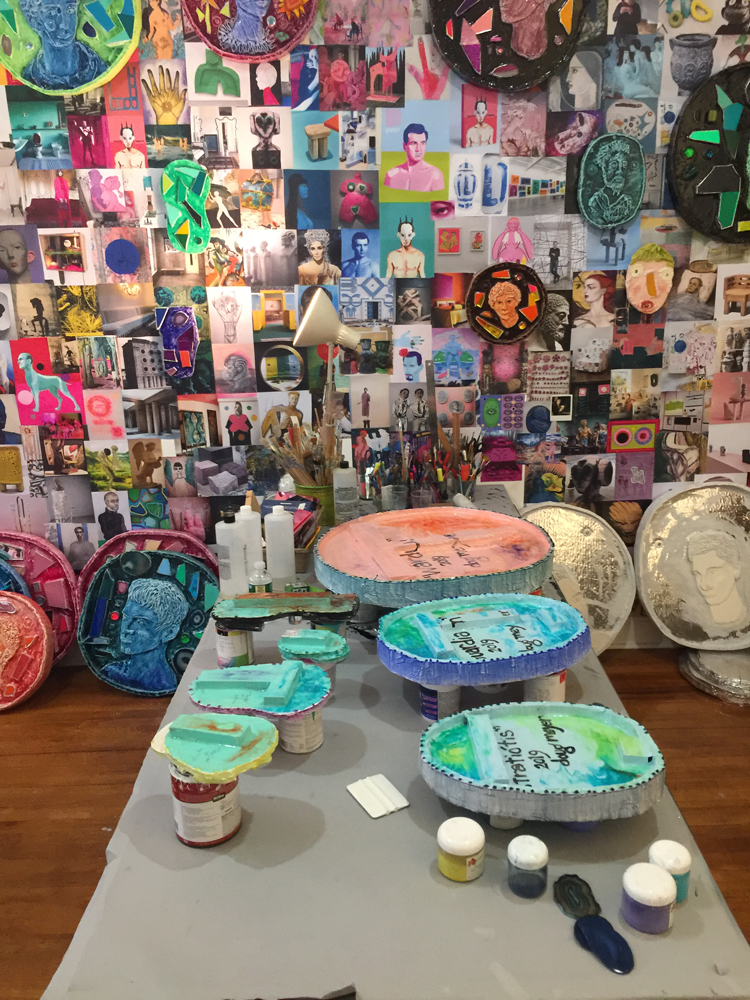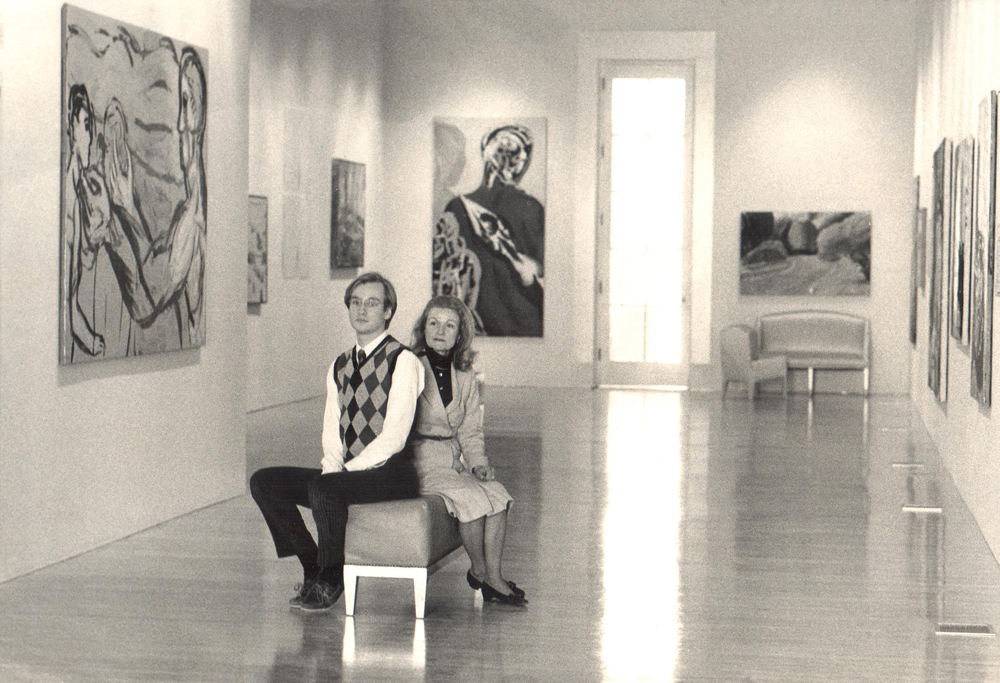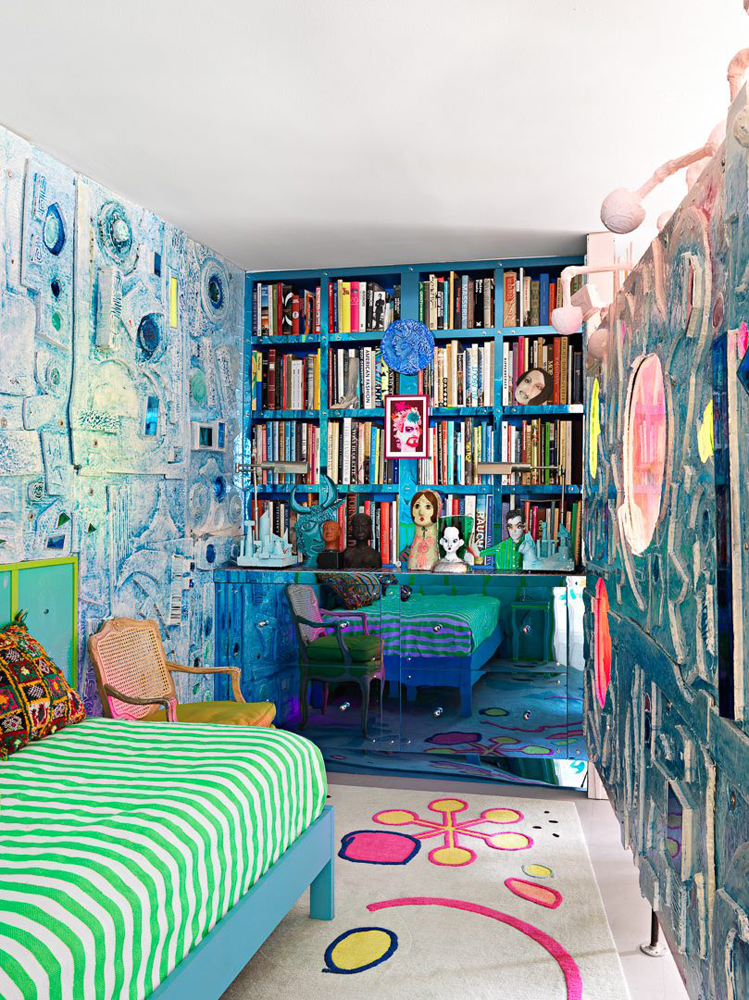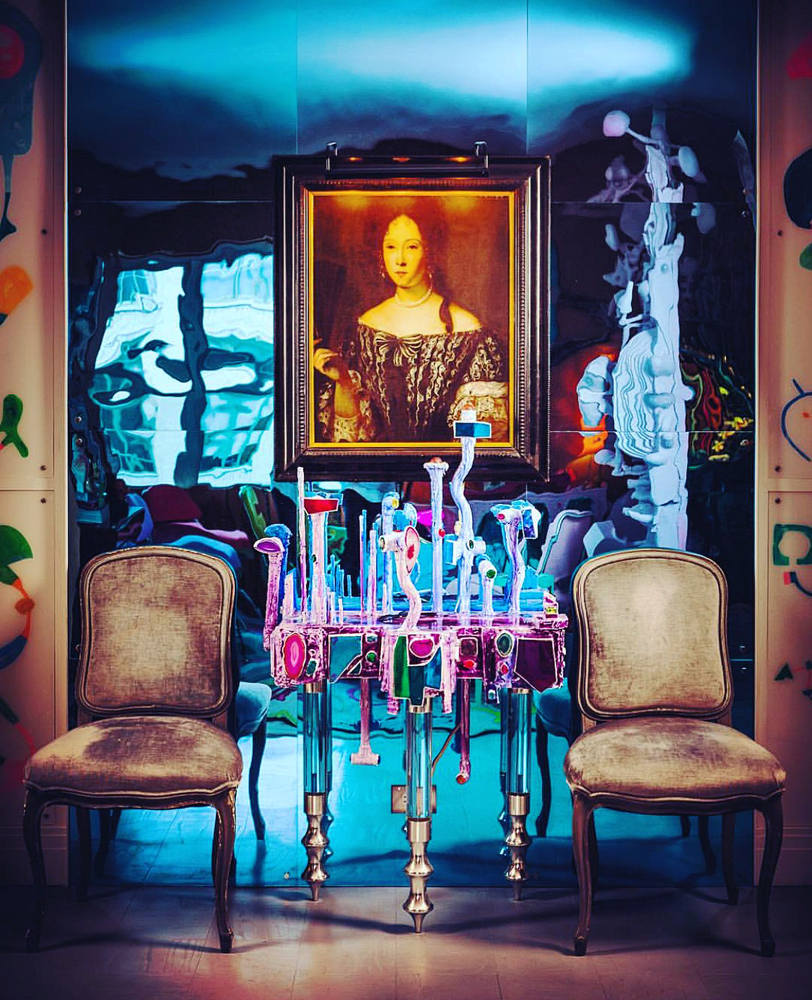Designer and artist Doug Meyer, 58, moved to New York as a young adult and has since had a wide-ranging career that has put his modern aesthetic on the covers of several international design magazines, including Architectural Digest. He published a book in June titled Heroes: A Tribute, in which he, through conceptual artworks, features 50 influential artists (from Robert Mapplethorpe to Freddie Mercury) who died of AIDS in the ’80s and ’90s. Meyer has another book coming out this month titled Doug Meyer: The Cameo Works. In this interview, he reflects on his formative years in Louisville and discusses his life as an artist.
How often do you come back to Louisville?
“When I moved away to New York, I would go home to Louisville for holidays and sometimes for a couple weeks in the summer. That’s when bigger planes used to fly into Louisville with US Airways. Really big planes. The reason I’m saying that is because I hadn’t been back to Louisville in like 25 years. About seven or eight months ago, I went back for the first time. I’ve been back since three times and I’m going again at the end of the month. My childhood best friend — and we have the exact same last name but we’re not related — her name is Joyce Meyer. I’ve known Joyce forever, but we reconnected a year and a half ago. You know how you haven’t seen someone in years or decades, but you get back together and everything picks up where you left off?
“It was so great coming back to Louisville. It was bizarre because everything seemed the same. We’d drive around and I knew what would be at the next turn. Things seemed smaller, or didn’t feel as far. The second time I went back after that was for the Speed Ball. That was fun seeing how much the Speed (Art Museum) had changed. I remember, too — oh my gosh, this was a billion years ago, after I graduated from Parsons: I moved back to Louisville and my mother had a gallery downtown. My parents owned a building at 624 West Main Street — I think it’s called the Meyer Building — and showed a lot of New York artists. Then we opened up a magazine that was short-lived called Kentucky Dossier. I was really young heading that up. It was like a Town & Country for Kentucky. It was fascinating doing that and traveling all over the state, especially in Lexington because of the horse industry.
“I am also currently working with Stephen Reily, (director) at the Speed. I am designing these very cool large-scale movable sofas and seating areas for the atrium. The pieces are an intersection of design and sculpture. They incorporate my love of color, unusual shapes and my love of plexiglass. I’m very excited and honored to be doing this for the Speed. The pieces are being fabricated locally by Solid Light, and they should be installed by January.”

Meyer's studio in New York.
What was growing up in Louisville like for you?
“My favorite thing about Louisville was going downtown. I was probably like 10 or 11 and was always fascinated with urban environments. We would be just driving from the East End and go through that weird little tunnel that kind of goes through Cherokee Park; then you’d get downtown and you’d see what used to be called the First National Tower, the big black building next to Humana. It was always fascinating to me because I love tall, old buildings. We’d go to (what was then) Stewart’s department store on Fourth Street. I loved being on that corner, because there was Rodes across the street, and Byck’s a few doors down. I always knew I was going to live in New York — I used to go all the time with my parents and in my late teens we had a house in the Hamptons — but downtown Louisville was the next best thing for me to New York.
“I remember during high school, Actors Theatre would always have their dress-rehearsal nights for high school students. I knew about theater because we would come to New York all the time and my mom would always buy like four million tickets to every play. I was always fascinated by the stage sets. When I moved to New York at 16, I never saw another play, though. I was kinda play’d out.
“There were so many things culturally that Louisville fulfilled for me, I think. Especially the Speed Art Museum back when it was way smaller and very quiet. It’s because of the Speed that I have a wonderful respect for museums and galleries. When you go in, there’s this kind of hushed moment. I used to go to the Speed at least once a week. They had the entrance with the columns and it was very grand. I remember when the Speed bought the Rembrandt painting — you know, that portrait of the lady that they have (Portrait of a Forty-Year-Old Woman, purchased in 1977). And there was this huge commotion around the whole town because it cost a million dollars. As a kid, I wished they would have spent that $1 million on modern stuff.”

Meyer with his mother at her gallery on Main Street in 1982 in Louisville.
Was there art everywhere in your childhood home in Louisville? Were your parents artists?
“It’s interesting. My father always wanted to be an artist, and he could draw really beautifully — he had really good line quality. I would always watch him draw. He’d help me as a kid with art projects. My father liked two things: art and golf. Golf was the one thing he got to keep doing. God knows he did that forever. My mother was very pretty, very, very stylish. She had a very good eye. Growing up, my parents built this really cool house in the ’60s. It was an all-white house with a two-story main section and a one-story living room that was huge and had glass on both sides and it jutted out. The front doors were painted neon pink with these huge Chinese brass door handles. So it was this really beautiful color combination of pink, gray and white. Everything was very, very modern. I mean, the dining room set and everything was Eero Saarinen — you know, the tulip chairs, the tulip table. I’ve always liked interesting interiors. The funny thing is, when I do interior, I love things on white, but I’ve never ever, ever been able to do a white room or create a white space because I just keep adding stuff into it and then the white somehow disappears.”
How would you describe your style?
“It’s always evolving. When I was a little kid in Louisville, I started collecting Art Deco. Lord, like in the ’70s, there was this publisher called Octopus Books and they had done these two books, one in Art Nouveau and one in Art Deco. And they were kind of the definitive guide, like a picture book for collecting. And Louisville had so many amazing antique fairs. One of the biggest ones was at the Fairgrounds. It was huge. I mean, it would take you literally like three days to go through all the booths and stuff. I collected like 40 percent of the stuff that was actually in that book.
“There was one antique fair at Mall St. Matthews on Saturdays. My mom would drop me off, make sure I got in. And then I would just explore all by myself, starting around age 11. My grandfather would always give me money every Sunday and I would hoard the money to buy all this stuff. And then sometimes I would resell stuff to dealers and buy something else. By the time I was 15, I did amass really kind of an amazing collection. I became very knowledgeable on that whole period. My grandmother got me started collecting match safes when I was around 10. From there it led to lots of research and I expanded to objects and small sculptures from both Deco and Nouveau in sterling silver. I would proudly display them in my bedroom and spend hours constantly arranging and rearranging them in displays and table-scape arrangements. I’m telling you this because I really don’t like Deco anymore. Once you’ve done something, you’ve done it. You kind of need to move on to something else. I have a great appreciation of Deco pieces in that period, but I don’t think I could ever live with any of them again.”

Meyer's living room in his New York apartment, featuring his wall sculpture titled “Deep Space” and a rug of his own design.
What was the nightlife like in Louisville when you were a teenager and young adult?
“The one place that I loved going to in Louisville was called the Downtowner. I don’t know when it closed, but it was a gay bar on Main Street. On the first floor in the back they had this theater with drag queens in there. They had the most amazing drag shows on the planet. They would actually sing. They were bouncing off the walls, screaming. They all had amazing voices. You know, you can’t take something like Studio 54 and put it in L.A. or Paris or Louisville. But the Downtowner was a really cool place. Louisville had quite a few places like that back then. Trust me — if you looked for them, you found them.”
In Louisville at that time, were you comfortable with being out?
“In New York and in bigger cities, no one really cares you’re gay. I really hated going to high school (at Eastern), because everyone was like, ‘Oh, look at this fag.’ Not that I thought I was faggy, but I guess I was. That’s why I did love when I went to summer school at Parsons between junior and senior year, because I was totally out then. When I say ‘out,’ it was no big deal, because most of the guys there were. We all felt safe and cool and everything was fine. In Louisville, I’d go to the Downtowner and feel OK when I later came home for the holidays. I just didn’t advertise it.”
You moved to New York two days after graduating high school. What was that like?
“Well, it actually started before I moved to New York because between my junior and senior years in high school, Parsons School of Design — where I eventually went and got a fine-arts degree — also had what they call the summer program, which was eight weeks with students from all over the country. You’re in classes Monday through Friday. I was living at the dorms at Parsons and, at that time, they shared dorms with New York University students. It was right there in the Village, on Fifth Avenue and 10th Street. An amazing location. That’s when I started going to Studio 54. I was 15. And, you know, the studio didn’t last very long. It was like a year and a half, two years. Centered around that there were all these other clubs that all held different types of people and moods. Like, there would be the Mudd Club downtown, which was more David Bowie — a little more punk, minimal. There were late-night after-hours clubs. New York was really grungy. I don’t like pristine. I like things that have a little edge to it. Then you go into the whole reason why I did the Heroes book, which was: The AIDS epidemic happened and things became very odd and very segregated. Everything began to change.”

A library on the other side of the wall sculpture in Meyer's apartment.
During that time, you went to 70-something funerals of friends. Was that a very dark period for you?
“When I moved to New York, I had these different groups of friends between school and going out. Every single one of them died. Every single one of them. It was the norm to hear that somebody you knew had just been diagnosed or entered the hospital or that they just died.
“It might sound odd, but the thing that really saved me was creating something and doing my art. It gave me a reason to get up in the mornings. When you’re creating something, you’re really into it. It’s like you can’t wait to get back to it. It’s very sort of cathartic. It’s kind of how creating all those Heroes sculptures were.
“The AIDS epidemic started in 1981 and one of the first people that died — one of the first in this series — was one of my best friends. I remember going over to his apartment after he had died. The police had blocked off the entire block. I was going over there with our other best friend to pick up some of this stuff. They had the people in Hazmat suits. There were huge trucks. We were watching all of the contents from his apartment being taken out and wrapped in bags and put in these vans, because, at the time, they thought AIDS was an airborne disease. They didn’t know how it was transmitted. Right after he died, literally it was within three or four months, it was a funeral every week or more. I went through that for a couple years. It was like I was in a daze, in a way.”
Tell me more about Heroes.
“I have such a library of knowledge when it comes to making stuff. I can weld, I can paint, I can draw, I can sculpt, I can carve, I can do ceramics. I can do all this stuff. For that project, I wanted every one of them to look as if they’d been done by different artists with different hands. So people wouldn’t just focus on the style of the entire collection when you saw it in an exhibition. I wanted people to concentrate on that particular object of that particular person and become interested in them and then read their obituary and learn about them that way.
“Today, most of the stuff that I do is commissioned and I call them ‘cameos.’ They’re on a highly encrusted round surface and I’ll use semiprecious stones and agates and things. And then I sculpt the faces and they become much more intricate. I’m adding glass eyes and snakes and birds and all these elements. I’ve been doing that for eight years. They’ve gotten up to seven feet high and six feet wide on these big panels.
“The Heroes project came about when I got a call from Pam Jaccarino, the editor-in-chief at Luxe Interiors + Design magazine. It was 2014. Every year they have a (gallery) space at a Design Industry Foundation Fighting AIDS (DIFFA) dinner. I’m a big history buff and I’m always about trying to preserve history, so I decided to make these vignettes. The original group was 19 heroes. I wanted to remind people of who these people were and how important these people were in the history of creatives — whether art, fashion, journalism. I remember the night of the big dinner, there was every kind of major who’s who of design there, like 200 people. People were crying. Some people came over to me and hugged me, thanked me for doing this. You never really know how people are going to react. It was a very painful experience, in a way. The exhibition has blossomed into 50 heroes, and it’s been in New York, Miami, Los Angeles.”

Meyer's apartment entryway.
The diversity within the pieces draws you in to each person.
“One of the portraits is of the fashion designer Patrick Kelly, who was from Mississippi. He was African-American. He left the U.S. and went to Paris and became a huge fashion designer. I had this huge collection of buttons and Kelly’s signature pieces always included these huge, huge, oversized buttons that were usually in primary colors on these outfits. One famous moment is, when Bette Davis was on the David Letterman show, she wore a Patrick Kelly outfit. She had this big hat on, a black skin-tight sheath dress on with these big buttons going down the front of it. And the hat was just all made of buttons.
“One of the things that (Kelly) did with his company — he was a huge fan of black memorabilia, and so he would collect these, you know, like Aunt Jemimas and golliwogs. He used a golliwog on his label. The NAACP freaked out because it’s so politically incorrect. I ended up portraying his face as the golliwog head because it was something that he loved and a part of his symbol. I meshed that with the buttons. There was so much strange thought into why I’d use certain materials. So much of my work is very conceptual. It becomes like a dialogue.”
This originally appeared in the November 2019 issue of Louisville Magazine under the headline “‘The White Somehow Disappears.’” To subscribe to Louisville Magazine, click here. To find us on newsstands, click here.
Cover photo by Danny Alexander, dannyalexanderphoto.com


